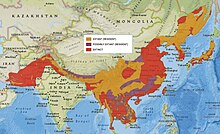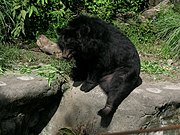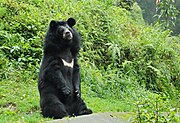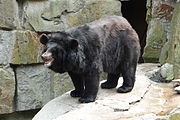এছিয়াৰ ক'লা ভালুক
| এছিয়াৰ ক'লা ভালুক সাময়িক পৰিসৰ: Early Pliocene–Recent | |
|---|---|

| |
| At Wrocław Zoo, পোলেণ্ড | |
| সংৰক্ষণ স্থিতি | |
| বৈজ্ঞানিক শ্ৰেণীবিভাজন | |
| অধিজগৎ: | সংকোষকেন্দ্ৰী |
| ৰাজ্য: | প্ৰাণী |
| পৰ্ব: | পৃষ্ঠদণ্ডী |
| শ্ৰেণী: | স্তন্যপায়ী |
| বৰ্গ: | Carnivora |
| পৰিয়াল: | Ursidae |
| গণ: | Ursus |
| প্ৰজাতি: | U. thibetanus |
| দ্বৈৰাশিক নামকৰণ | |
| Ursus thibetanus G. Cuvier, 1823 | |
| Subspecies | |
|
7, see text | |

| |
| ২০১৬ চনত এছিয়াৰ ক'লা ভালুকৰ পৰিসৰ | |
| সমাৰ্থক | |
|
চেলেনাৰ্কটোচ থিবেটেনাছ | |
এছিয়াৰ ক'লা ভালুক (উৰ্চাছ থিবেটেনাছ)ইংৰাজী: Asian black bear যাক ভাৰতীয় ক'লা ভালুক, এছিয়াৰ ক'লা ভালুক, চন্দ্ৰ ভালুক আৰু বগা বুকুৰ ভালুক বুলিও জনা যায়। ক'লা ভালুক হৈছে এছিয়াৰ স্থানীয় এক মজলীয়া আকাৰৰ ভালুকৰ প্ৰজাতি। ক'লা ভালুক হিমালয়ৰ অংশবিশেষ, দক্ষিণ-পূব ইৰাণ, ভাৰতীয় উপমহাদেশৰ উত্তৰ অংশ, দক্ষিণ-পূব এছিয়াৰ মূলভূমি, কোৰিয়াৰ উপদ্বীপ, চীন, ৰাছিয়াৰ অংশবিশেষ, জাপানৰ হনশ্বু আৰু শিকোকু দ্বীপ আৰু টাইৱানত বাস কৰা দেখা যায়। ইয়াক আই.ইউ.চি.এন.(IUCN)ৰ ৰঙা তালিকাত অসুৰক্ষিত প্ৰাণী হিচাপে তালিকাভুক্ত কৰা হৈছে। কিয়নো অন্ধবিশ্বাসৰ বশৱৰ্তী হৈ ক'লা ভালুকৰ শৰীৰৰ অংশবোৰ পৰম্পৰাগত ঔষধত ব্যৱহাৰ কৰা হয়। লগতে বনধ্বংস আৰু চোৰাং চিকাৰৰ দ্বাৰা কবলত পৰা বাবেও এই প্ৰাণী বিধ লাহেকৈ কমি আহিছে। এছিয়াৰ ক'লা ভালুকৰ প্ৰাচীনতম জ্ঞাত নমুনাবোৰ মলদোভাৰ প্ৰাৰম্ভিক প্লিঅচিনৰ পৰা জনা যায়।[2]
বৈশিষ্ট্য আৰু আচৰণ
[সম্পাদনা কৰক]আকৃতি
[সম্পাদনা কৰক]এছিয়াৰ ক'লা ভালুক১.২-২ মিটাৰ লৈকে ডাঙৰ হয়। এছিয়াৰ ক'লা ভালুকৰ ক'লা নোম, পাতল মুগা মুখ, আৰু বুকুত এক পৃথক বগা বা ক্ৰীম ৰঙৰ নোম থাকে আৰু এয়া কেতিয়াবা ভি-আকৃতিৰ হয়।[3][4] ইয়াৰ কাণবোৰ ঘণ্টাৰ আকৃতিৰ দৰে, আন ভালুকবোৰতকৈ সমানুপাতিকভাৱে দীঘল, আৰু মুৰৰ পৰা কাষত লাগি থাকে। ইয়াৰ নেজ চুটি, প্ৰায় ১১ চেমি (৪.৩ ইঞ্চি) দীঘল।[5] মেৰু ভালুকৰ বিপৰীতে, এছিয়ান ক'লা ভালুকৰ গছ বগাবলৈ এক শক্তিশালী ওপৰৰ শৰীৰ আছে, আৰু তুলনামূলকভাৱে দুৰ্বল পিছৰ ভৰি যি মুগা ভালুক আৰু আমেৰিকান ক'লা ভালুকৰ ভৰিতকৈ চুটি।
অন্যান্য বৈশিষ্ট্য
[সম্পাদনা কৰক]ক'লা ভালুক অতি অলস। কিন্তু যেতিয়া এইবিধ প্ৰাণী যুঁজ দিবলৈ যায়, তেওঁলোকৰ দীঘলীয়া সময়ৰ বাবে শক্তি থাকে। এছিয়াৰ ক'লা ভালুকবোৰ আন কেইবাটাও ভালুকৰ প্ৰজাতিৰ সৈতে কেতিয়াবা সুসঙ্গত প্ৰজননগতভাৱে উন্নত প্ৰজাতিৰ সন্তান উৎপন্ন কৰে।


বিস্তৃতি আৰু বাসস্থান
[সম্পাদনা কৰক]এছিয়াৰ ক'লা ভালুক এসময়ত মধ্য প্লেইষ্টোচিন আৰু প্ৰাৰম্ভিক লেট প্লেইষ্টোচিনৰ সময়ত পশ্চিম ইউৰোপৰ দৰে পশ্চিমলৈকে বিস্তৃত আছিল। যদিও এতিয়া ইয়াৰ পূৰ্বৰ পৰিসৰ সলনি ঘটে, আৰু এতিয়া এছিয়াত সীমাবদ্ধ। বৰ্তমান দক্ষিণ-পূব ইৰাণৰ পৰা আফগানিস্তানৰ পূব দিশে আৰু পাকিস্তানৰ অংশ বিশেষ, ভাৰত আৰু ম্যানমাৰৰ হিমালয়ৰ পাদদেশৰ পাৰ হৈ মালয়েছিয়াৰ বাহিৰে দক্ষিণ-পূব এছিয়াৰ মূল ভূখণ্ডলৈকে ক'লা ভালুক দেখা যায়। উত্তৰ-পূব আৰু দক্ষিণ চীনত ক'লা ভালুকৰ পৰিসৰ কম, আৰু পূব-মধ্য চীনৰ বেছিভাগ অঞ্চলতেই দেখা নাযায়। দক্ষিণ ৰাছিয়াৰ দূৰ পূব আৰু উত্তৰ কোৰিয়াৰ অন্যান্য অঞ্চলত ক'লা ভালুকৰ জনসংখ্যাৰ গোট বিদ্যমান। দক্ষিণ কোৰিয়াত এটা সৰু অৱশিষ্ট জনসংখ্যা জীয়াই আছে। এছিয়াৰ ক'লা ভালুক জাপানৰ হোনচু আৰু শিকোকু দ্বীপৰ লগতে টাইৱান আৰু চীনা দ্বীপ হাইনানতো দেখা যায়।
বাংলাদেশ
[সম্পাদনা কৰক]বাংলাদেশৰ ৱাইল্ডলাইফ ট্ৰাষ্টে ২০০৮ চনৰ পৰা ২০১০ চনলৈ বাংলাদেশত ভালুকৰ ক্ষেত্ৰত জৰীপ চলাইছিল য'ত এছিয়ান ক'লা ভালুক অন্তৰ্ভুক্ত আছিল। জৰীপটো ৮৭টা বিভিন্ন স্থানত কৰা হৈছিল, বেছিভাগ বাংলাদেশৰ উত্তৰ-মধ্য, উত্তৰ-পূব আৰু দক্ষিণ-পূব অঞ্চলত য'ত ভালুকৰ পূৰ্বতে উপস্থিতি আছিল। জৰীপৰ ফলাফলত কোৱা হৈছে যে বেছিভাগ অঞ্চলত এতিয়াও কিছুমান বিচ্ছিন্ন সৰু ভালুকৰ সংখ্যা আছে, মুখ্যতঃ এছিয়ান ক'লা ভালুক।
চীন
[সম্পাদনা কৰক]এছিয়াৰ ক'লা ভালুকৰ তিনিটা উপপ্ৰজাতি চীনত দেখা যায়। সেইকেইটা হ'ল তিব্বতীয় উপপ্ৰজাতি (ইউ. থিবিটেনাছ থিবিটেনাছ), ইণ্ডোচাইনিজ উপপ্ৰজাতি (ইউ. থিবিটেনাছ মুপিনেনচিছ), আৰু উত্তৰ-পূবৰ উপ-প্ৰজাতি (ইউ. থিবেটেনাছ উচুৰিকাছ), যি হৈছে উত্তৰ-পূব চীনত ভালুকৰ একমাত্ৰ উপপ্ৰজাতি। এছিয়ান ক'লা ভালুকবোৰ মুখ্যতঃ উত্তৰ-পূব চীনৰ ঠাণ্ডা আৰু নাতিশীতোষ্ণ অঞ্চলৰ কনিফাৰ অৰণ্যত ইয়াৰ জনসংখ্যা আছে। মুখ্য অঞ্চলবোৰ হৈছে চাং বাই, ঝাং গুয়াংকাই, লাও য়ে, আৰু লেচাৰ জিঙ্গান পৰ্বতমালা।
কোৰিয়া
[সম্পাদনা কৰক]কোৰিয়াত, বেছিভাগ এছিয়ান ক'লা ভালুক জিৰিচানৰ পৰা ১,৫০০ মিটাৰ উত্তৰে আলপাইন অঞ্চলৰ অৰণ্যত বাস কৰে।
চাইবেৰিয়া
[সম্পাদনা কৰক]চাইবেৰিয়া অঞ্চলতো ক’লা ভালুক দেখা যায়।
উপ-প্ৰজাতিবোৰ
[সম্পাদনা কৰক]| উপপ্ৰজাতিৰ নাম | সাধাৰণ নাম | বিতৰণ | বিৱৰণ |
|---|---|---|---|
| উৰ্চাছ থিবিটেনাছ ফৰ্মোচানাছ R. Swinhoe, ১৮৬৪ 
|
ফৰ্মোচান ক'লা ভালুক | টাইৱান | এই উপপ্ৰজাতিটোত অন্যান্য উপপ্ৰজাতিৰ ডাঠ ডিঙিৰ পশমৰ অভাৱ আছে।[6] |
| উৰ্চাছ থিবেটেনাছ গেড্ৰোচিয়ানাছ ব্লেনফৰ্ড, ১৮৭৭ 
|
বেলুচিস্তান ক'লা ভালুক | দক্ষিণ বেলুচিস্তান[7] | তুলনামূলকভাৱে চুটি, মোটা চুলিৰ এক সৰু উপ-প্ৰজাতি, প্ৰায়ে ক'লাৰ সলনি ৰঙা-মুগা।[7] |
উৰ্চাছ থিবেটেনাছ জেপোনিকাচ Schlegel, ১৮৫৭
|
জাপানী ক'লা ভালুক | হনশ্বু আৰু শিকোকু। কিউচুত বিলুপ্ত। | এই সৰু উপপ্ৰজাতিৰ ভালুকৰ প্ৰাপ্তবয়স্ক পুৰুষৰ ওজন ৬০-১২০ কিগ্ৰা (১৩০-২৬০ পাউণ্ড) আৰু প্ৰাপ্তবয়স্ক মহিলাৰ বাবে ৪০-১০০ কিগ্ৰা (৮৮-২২০ পাউণ্ড) ওজনৰ এটা সৰু উপপ্ৰজাতি। শৰীৰৰ গড় দৈৰ্ঘ্য হৈছে ১.১-১.৪ মিটাৰ (৩ ফুট ৭ ইঞ্চি – ৪ ফুট ৭ ইঞ্চি)। ইয়াত অন্যান্য উপ-প্ৰজাতিৰ দৰে ঘনকৈ ডিঙিৰ নোমৰ অৱস্থিতি কম দেখা যায়। আৰু এইবিধ ভালুকৰ গাঢ় নাক আছে।[6] |
উৰ্চাছ থিবেটেনাছ লানিগাৰ পকক, ১৯৩২
|
হিমালয়ৰ ক'লা ভালুক | the Himalayas[7] | ইয়াৰ দীঘল, ডাঠ পশম আৰু সৰু, বগা বুকুৰ চিহ্নৰ দ্বাৰা ইউ. টি. থিবিটেনাছৰ পৰা পৃথক। গ্ৰীষ্মকালত, নেপাল, চীন, চাইবেৰিয়া আৰু তিব্বতৰ উষ্ণ অঞ্চলত ৩,০০০-৩,৬০০ মিটাৰ (৯,৮০০-১১,৮০০ ফুট) উচ্চতাত হিমালয়ৰ ক'লা ভালুক হয়। শীতকালৰ বাবে, সেইবোৰ ১,৫০০ মিটাৰ (৪,৯০০ ফুট)ৰ তললৈ নামি আহে। গড় হিচাপত, তেওঁলোকে নাকৰ পৰা নেজলৈ ১.৪-১.৬ মিটাৰ (৪ ফুট ৭ ইঞ্চি – ৫ ফুট ৩ ইঞ্চি) জোখে আৰু ওজন ৯০-১২০ কিগ্ৰা (২০০-২৬০পাউণ্ড)ৰ পৰা হয়, যদিও কেতিয়াবা হিমালয়ৰ ক'লা ভালুক শীতনিদ্ৰাৰ বাবে শকত হৈ থাকে তেতিয়া এই প্ৰাণীবিধৰওজন ১৮১ কিগ্ৰা (৩৯৯ পাউণ্ড) হ'ব পাৰে।[8] |
| উৰ্চাছ থিবেটেনাছ মুপিনেনচিছ Heude, ১৯০১ |
ইণ্ডোচাইনিজ ক'লা ভালুক | ইন্দোচীন | পাতল ৰঙৰ, ইউ. টি. লানিগাৰৰ দৰে |
উৰ্চাছ থিবেটেনাছ থিবেটেনাছ কাভিয়েৰ, ১৮২৩ 
|
তিব্বতীয় ক'লা ভালুক | অসম, নেপাল, ম্যানমাৰ, Mergui, থাইলেণ্ড আৰু আনাম[7] | ইয়াৰ চুটি, পাতল নোমৰ দ্বাৰা ইউ. টি. লানিগাৰৰ পৰা পৃথক কৰা হৈছে য'ত কমৰ পৰা শৰীৰৰ তলৰফালে নোম নাই।[7] |
| উৰ্চাছ থিবেটেনাছ উচচুৰিকচ Heude, 1901 | উচুৰি ক'লা ভালুক | দক্ষিণ চাইবেৰিয়া, উত্তৰ-পূব চীন আৰু কোৰিয়ান উপদ্বীপ | আটাইতকৈ ডাঙৰ উপপ্ৰজাতি[9][6] |
তথ্য সংগ্ৰহ
[সম্পাদনা কৰক]- ↑ ইয়ালৈ যাওক: 1.0 1.1 Garshelis, D.; Steinmetz, R. (2020). Ursus thibetanus. p. e.T22824A166528664. doi:10.2305/IUCN.UK.2020-3.RLTS.T22824A166528664.en.
- ↑ G. F. Baryshnikov and D. S. Zakharov. 2013. Early Pliocene Bear Ursus thibetanus (Mammalia, Carnivora) from Priozernoe Locality in the Dniester Basin (Moldova Republic). Proceedings of the Zoological Institute RAS 317(1):3-10
- ↑ Stirling, I., ed (1993). Bears, Majestic Creatures of the Wild. প্ৰকাশক Emmaus: Rodale Press. http://www.bearbiology.com/index.php?id=36। আহৰণ কৰা হৈছে: December 21, 2014.
- ↑ "Asiatic Black Bear". Yadanarbon Zoo. https://www.mdyzoo.com/floras/asiatic-black-bear/। আহৰণ কৰা হৈছে: Nov 12, 2022.
- ↑ Brown, Bear Anatomy and Physiology
- ↑ ইয়ালৈ যাওক: 6.0 6.1 6.2 Baluchistan black bear Ursus thibetanus (G. Cuvier, 1823)
- ↑ ইয়ালৈ যাওক: 7.0 7.1 7.2 7.3 7.4 Pocock, R. I. (1941). The Fauna of British India, Including Ceylon and Burma: Mammalia Volume 2. Taylor and Francis, London.
- ↑ Bears Of The World. "Himalayan Black Bear". Bears Of The World. Archived from the original on 20 March 2015. https://web.archive.org/web/20150320190723/http://www.bearsoftheworld.net/himalayan_black_bears.asp। আহৰণ কৰা হৈছে: 20 March 2015.
- ↑ Heptner, V. G.; Naumov, N. P. (1992). "White-chested, black bear". Mlekopitajuščie Sovetskogo Soiuza. Moskva: Vysšaia Škola [Mammals of the Soviet Union. Vol. II Part 1a, Sirenia and Carnivora (Sea cows; Wolves and Bears)]. প্ৰকাশক Washington DC: Smithsonian Institution and the National Science Foundation. পৃষ্ঠা. 713–733. https://archive.org/stream/mammalsofsov211998gept#page/712/mode/2up.



